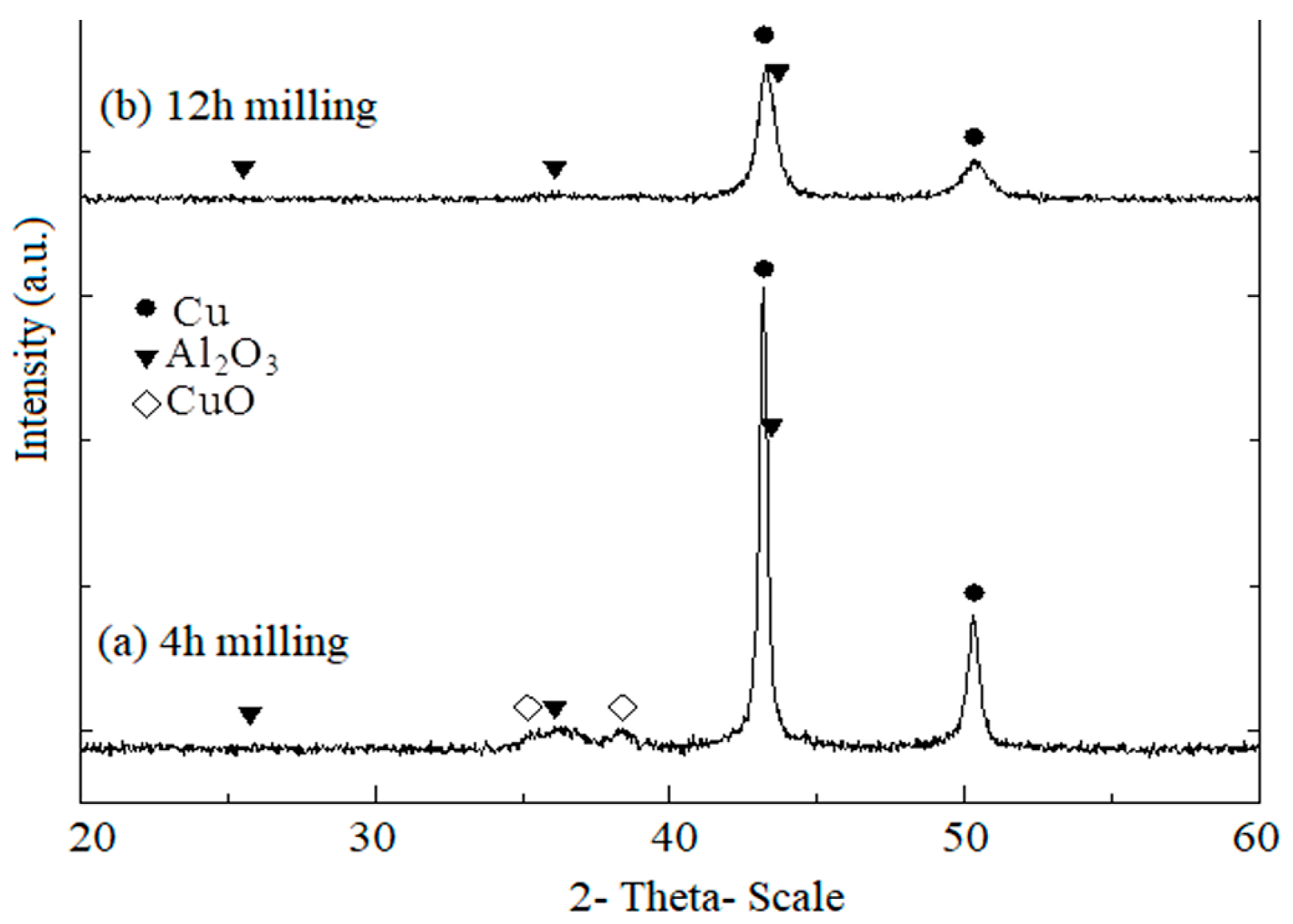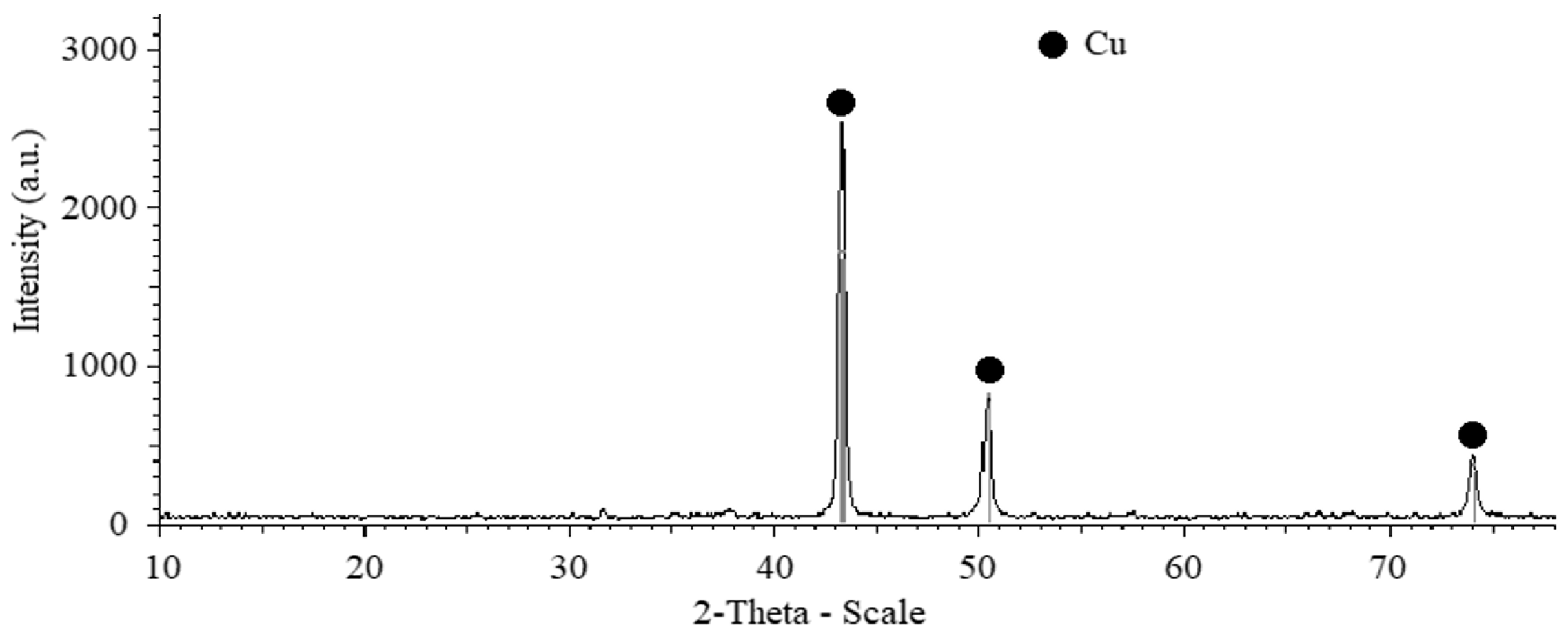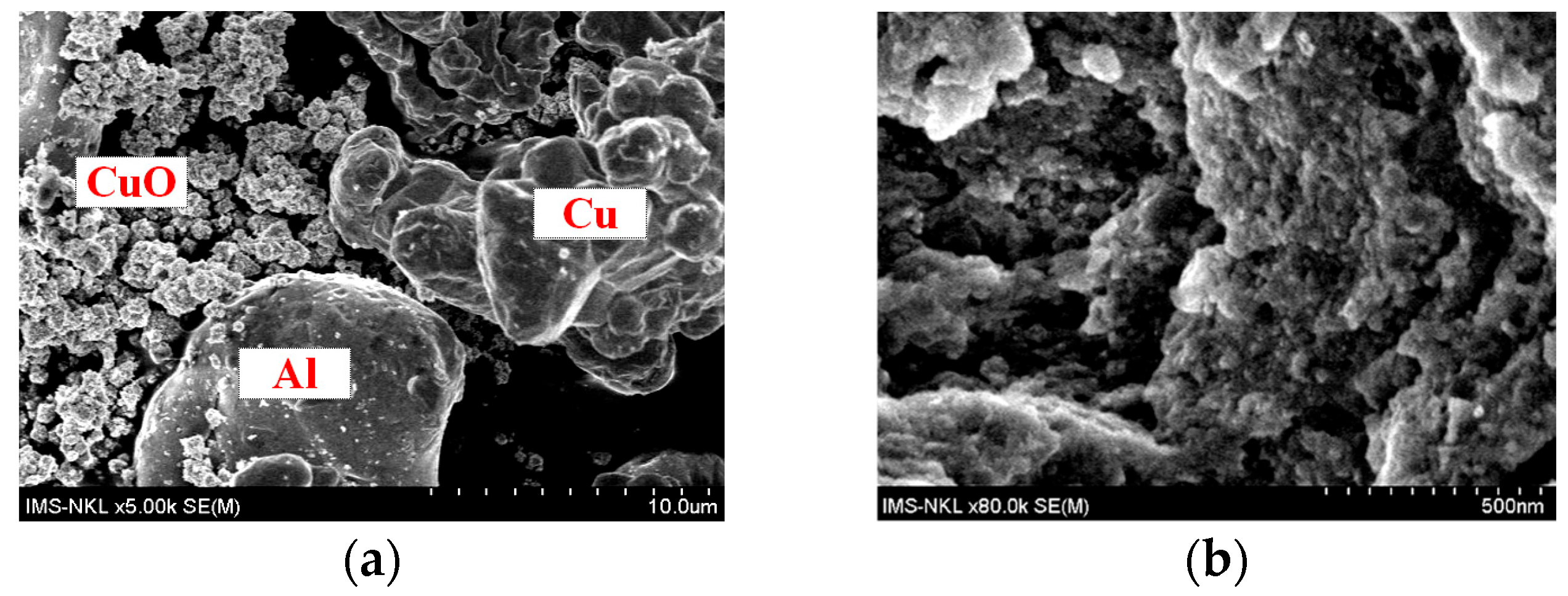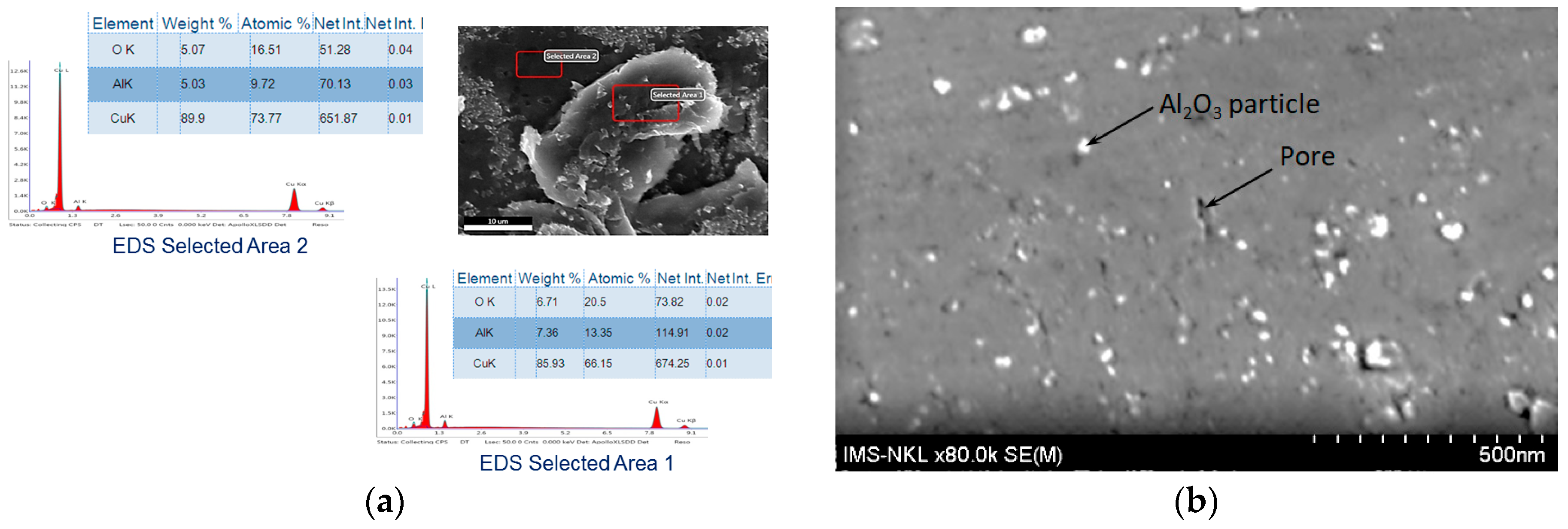Properties of Cu-Al2O3 Nanocomposite Materials Synthesized by Mechano-Chemical Process †
Abstract
1. Introduction
2. Materials and Methods
3. Results and Discussion
3.1. Phase Formation
3.2. Microstructures
3.3. Effects of Input Parameters on the Properties of Cu-(5 vol.%) Al2O3 Nanocomposite Materials
4. Conclusions
Author Contributions
Funding
Institutional Review Board Statement
Informed Consent Statement
Data Availability Statement
Acknowledgments
Conflicts of Interest
References
- Lee, D.W.; Kim, B.K. Nanostructured Cu–Al2O3 composite produced by thermochemical process for electrode application. Mater. Lett. 2004, 58, 378–383. [Google Scholar] [CrossRef]
- Annaraj, J.P.; Bose, N.; Hynes, N.R.J. A review on mechanical and tribological properties of sintered copper matrix composites. AIP Conf. Proc. 2019, 2142, 070027. [Google Scholar] [CrossRef]
- Lu, L.; Shen, Y.; Chen, X.; Qian, L.; Lu, K. Ultrahigh Strength and High Electrical Conductivity in Copper. Science 2004, 304, 422–426. [Google Scholar] [CrossRef] [PubMed]
- Huang, A.H.; Wang, Y.F.; Wang, M.S.; Song, L.Y.; Li, Y.S.; Gao, L.; Huang, C.X.; Zhu, Y.T. Optimizing the strength, ductility and electrical conductivity of a Cu–Cr–Zr alloy by rotary swaging and aging treatment. Mater. Sci. Eng. A 2019, 746, 211–216. [Google Scholar] [CrossRef]
- Botcharova, E.; Freudenberger, J.; Schultz, L. Mechanical and electrical properties of mechanically alloyed nanocrystalline Cu–Nb alloys. Acta Mater. 2006, 54, 3333–3341. [Google Scholar] [CrossRef]
- Motaman, A.; Salahi, E. Synthesis of Cu–Al2O3 metal matrix nanocomposite powder from CuO and Al powders by using high energy planetary fast milling. Int. J. Nanosci. 2011, 08, 261–266. [Google Scholar] [CrossRef]
- Sridhar, M.M.J.; Ravichandran, M.; Meignanamoorthy, M. Influence of different reinforcements on properties of copper matrix composites: A review. AIP Conf. Proc. 2020, 2283, 020129. [Google Scholar] [CrossRef]
- Alaneme, K.K.; Odoni, B.U. Mechanical properties, wear and corrosion behavior of copper matrix composites reinforced with steel machining chips. Eng. Sci. Technol. Int. J. 2016, 19, 1593–1599. [Google Scholar] [CrossRef]
- Pan, S.; Zheng, T.; Yao, G.; Chi, Y.; De Rosa, I.; Li, X. High-strength and high-conductivity in situ Cu–TiB2 nanocomposites. Mater. Sci. Eng. A 2022, 831, 141952. [Google Scholar] [CrossRef]
- Sulima, I.; Boczkal, G. Processing and Properties of ZrB2–Copper Matrix Composites Produced by Ball Milling and Spark Plasma Sintering. Materials 2023, 16, 7455. [Google Scholar] [CrossRef] [PubMed]
- Rezayat, M.; Karamimoghadam, M.; Ashkani, O.; Bodaghi, M. Characterization and Optimization of Cu–Al2O3 Nanocomposites Synthesized via High Energy Planetary Milling: A Morphological and Structural Study. J. Compos. Sci. 2023, 7, 300. [Google Scholar] [CrossRef]
- Shen, D.; Gao, P.; He, Y.; Gong, J.; Du, J. A Cu–Al2O3 Composite with Ultrahigh Tensile Strength Prepared by High-Pressure Torsion. J. Mater. Eng. Perform. 2022, 31, 9425–9430. [Google Scholar] [CrossRef]
- Mittal, P.; Paswan, M.K.; Sadasivuni, K.K.; Gupta, P. Structural, wear and thermal behaviour of Cu–Al2O3–graphite hybrid metal matrix composites. Proc. Inst. Mech. Eng. Part L J. Mater. Des. Appl. 2020, 234, 1154–1164. [Google Scholar] [CrossRef]
- Rocha-Rangel, E.; Miranda-Hernández, J.G. Alumina-Copper Composites with High Fracture Toughness and Low Electrical Resistance. Mater. Sci. Forum 2010, 644, 43–46. [Google Scholar] [CrossRef]
- Koumoulos, E.P.; Kartsonakis, I.A.; Bakolas, A.; Charitidis, C.A. Nanomechanical properties and thermal decomposition of Cu–Al2O3 composites for FGM applications. Manuf. Rev. 2016, 3, 20. [Google Scholar] [CrossRef]
- Hwang, S.J.; Lee, J.-H. Mechanochemical synthesis of Cu–Al2O3 nanocomposites. Mater. Sci. Eng. A 2005, 405, 140–146. [Google Scholar] [CrossRef]
- Jena, P.K.; Brocchi, E.A.; Motta, M.S. In-situ formation of Cu–Al2O3 nano-scale composites by chemical routes and studies on their microstructures. Mater. Sci. Eng. A 2001, 313, 180–186. [Google Scholar] [CrossRef]
- Yan, Y.-F.; Kou, S.-Q.; Yang, H.-Y.; Shu, S.-L.; Qiu, F.; Jiang, Q.-C.; Zhang, L.-C. Ceramic particles reinforced copper matrix composites manufactured by advanced powder metallurgy: Preparation, performance, and mechanisms. Int. J. Extrem. Manuf. 2023, 5, 032006. [Google Scholar] [CrossRef]
- Feng, X.; Zhang, D.; Feng, B.; Lin, Y.; Wang, J.; Zheng, K. Microstructure and Properties of Cu–0.4 wt.% Al2O3 Composites Fabricated by Hot Extrusion and Cold Drawing. J. Mater. Eng. Perform. 2022, 31, 1241–1249. [Google Scholar] [CrossRef]
- Mittal, P.; Sengar, S.S.; Sorabh; Paswan, M.K.; Mehta, J.; Chawla, D.; Gupta, P. Challenges and Opportunities in Synthesis of Hybrid Cu–Al2O3–C and Cu–ZrO2–C Composites Through Stir Casting Route. In Advances in Engineering Materials: Select Proceedings of FLAME 2020; Springer: Singapore, 2021; pp. 1–9. [Google Scholar]








| Raw Materials | Purity (%) | Average Sizes (μm) |
|---|---|---|
| CuO powder | ≥99.8% | about 0.5–1.0 |
| Cu powder | ≥99.7% | about 2–3 |
| Al powder | ≥99.7% | about 10–20 |
| Input Parameters | Symbol | Unit | Lower Values | Upper Values |
|---|---|---|---|---|
| Compressive pressure | p | MPa | 200 | 400 |
| Sintering temperature | T | °C | 700 | 900 |
| Sintering time | ts | h | 1.0 | 3.0 |
| Std Order | Run Order | Input Parameters | Properties of Cu-(5 vol.%) Al2O3 Nanocomposite Materials | ||||
|---|---|---|---|---|---|---|---|
| p (MPa) | T (°C) | ts (h) | Porosity (%) | Microhardness (HV) | IACS (%) | ||
| 1 | 1 | 200 | 700 | 1 | 17.45 | 96 | 53.76 |
| 2 | 6 | 400 | 700 | 3 | 10.78 | 126 | 70.64 |
| 3 | 8 | 400 | 900 | 3 | 11.97 | 118 | 68.26 |
| 4 | 7 | 200 | 900 | 3 | 18.09 | 90 | 52.32 |
| 5 | 3 | 200 | 900 | 1 | 16.71 | 99 | 56.36 |
| 6 | 4 | 400 | 900 | 1 | 12.73 | 114 | 66.28 |
| 7 | 2 | 400 | 700 | 1 | 10.01 | 120 | 71.24 |
| 8 | 5 | 200 | 700 | 3 | 17.94 | 93 | 53.24 |
Disclaimer/Publisher’s Note: The statements, opinions and data contained in all publications are solely those of the individual author(s) and contributor(s) and not of MDPI and/or the editor(s). MDPI and/or the editor(s) disclaim responsibility for any injury to people or property resulting from any ideas, methods, instructions or products referred to in the content. |
© 2025 by the authors. Licensee MDPI, Basel, Switzerland. This article is an open access article distributed under the terms and conditions of the Creative Commons Attribution (CC BY) license (https://creativecommons.org/licenses/by/4.0/).
Share and Cite
Ho, K.-T.; Nguyen, D.-D. Properties of Cu-Al2O3 Nanocomposite Materials Synthesized by Mechano-Chemical Process. Eng. Proc. 2025, 111, 5. https://doi.org/10.3390/engproc2025111005
Ho K-T, Nguyen D-D. Properties of Cu-Al2O3 Nanocomposite Materials Synthesized by Mechano-Chemical Process. Engineering Proceedings. 2025; 111(1):5. https://doi.org/10.3390/engproc2025111005
Chicago/Turabian StyleHo, Ky-Thanh, and Duc-Duy Nguyen. 2025. "Properties of Cu-Al2O3 Nanocomposite Materials Synthesized by Mechano-Chemical Process" Engineering Proceedings 111, no. 1: 5. https://doi.org/10.3390/engproc2025111005
APA StyleHo, K.-T., & Nguyen, D.-D. (2025). Properties of Cu-Al2O3 Nanocomposite Materials Synthesized by Mechano-Chemical Process. Engineering Proceedings, 111(1), 5. https://doi.org/10.3390/engproc2025111005






